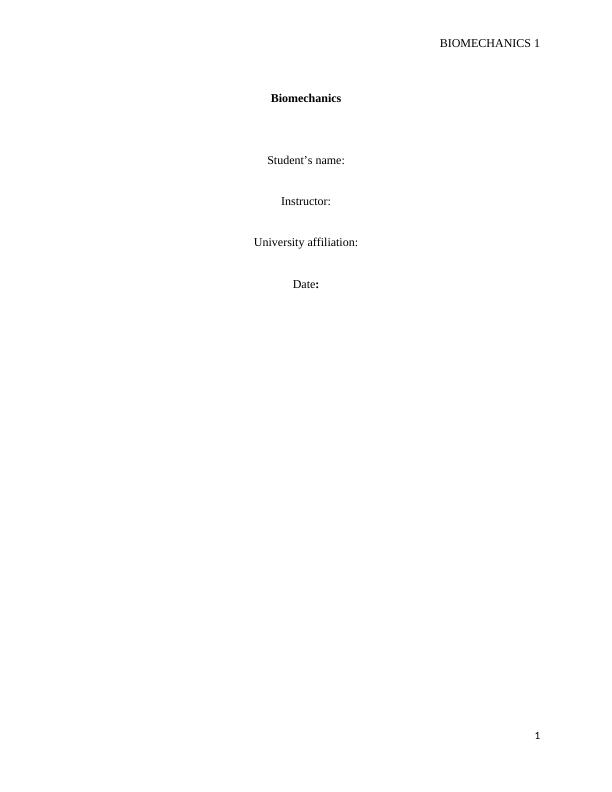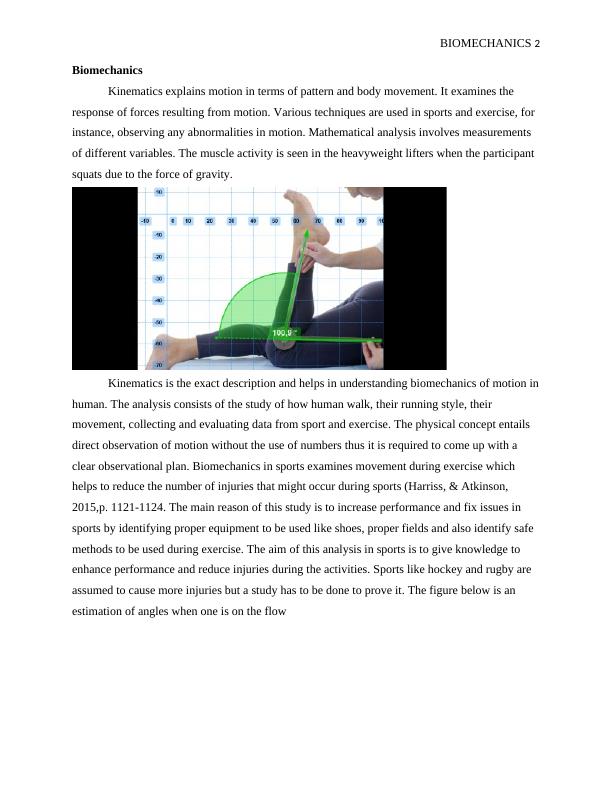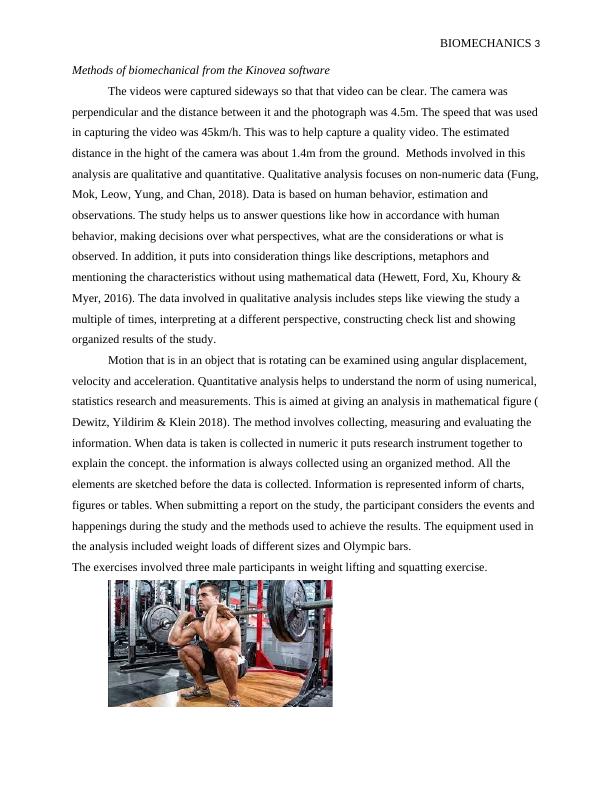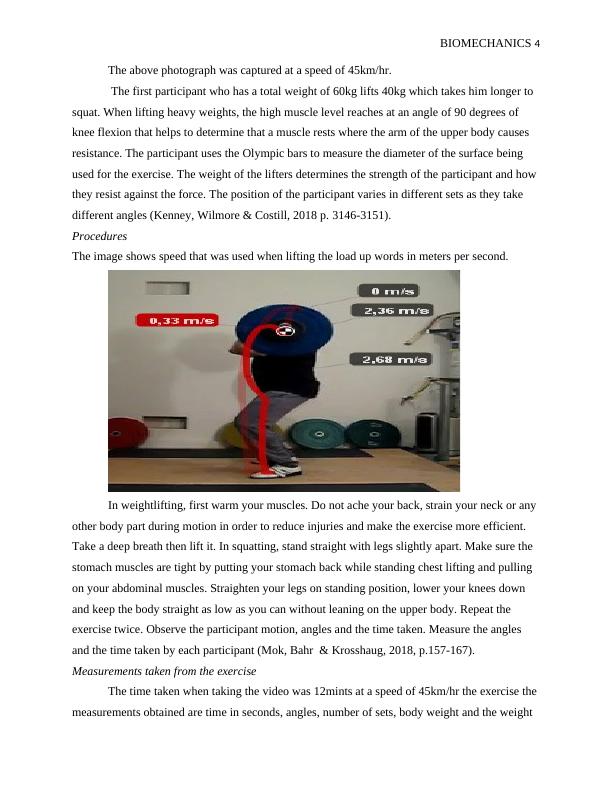Biomechanics in Sports and Exercise: Analysis of Kinematics and Methods
Added on 2023-04-25
11 Pages2490 Words306 Views
BIOMECHANICS 1
Biomechanics
Student’s name:
Instructor:
University affiliation:
Date:
1
Biomechanics
Student’s name:
Instructor:
University affiliation:
Date:
1

BIOMECHANICS 2
Biomechanics
Kinematics explains motion in terms of pattern and body movement. It examines the
response of forces resulting from motion. Various techniques are used in sports and exercise, for
instance, observing any abnormalities in motion. Mathematical analysis involves measurements
of different variables. The muscle activity is seen in the heavyweight lifters when the participant
squats due to the force of gravity.
Kinematics is the exact description and helps in understanding biomechanics of motion in
human. The analysis consists of the study of how human walk, their running style, their
movement, collecting and evaluating data from sport and exercise. The physical concept entails
direct observation of motion without the use of numbers thus it is required to come up with a
clear observational plan. Biomechanics in sports examines movement during exercise which
helps to reduce the number of injuries that might occur during sports (Harriss, & Atkinson,
2015,p. 1121-1124. The main reason of this study is to increase performance and fix issues in
sports by identifying proper equipment to be used like shoes, proper fields and also identify safe
methods to be used during exercise. The aim of this analysis in sports is to give knowledge to
enhance performance and reduce injuries during the activities. Sports like hockey and rugby are
assumed to cause more injuries but a study has to be done to prove it. The figure below is an
estimation of angles when one is on the flow
Biomechanics
Kinematics explains motion in terms of pattern and body movement. It examines the
response of forces resulting from motion. Various techniques are used in sports and exercise, for
instance, observing any abnormalities in motion. Mathematical analysis involves measurements
of different variables. The muscle activity is seen in the heavyweight lifters when the participant
squats due to the force of gravity.
Kinematics is the exact description and helps in understanding biomechanics of motion in
human. The analysis consists of the study of how human walk, their running style, their
movement, collecting and evaluating data from sport and exercise. The physical concept entails
direct observation of motion without the use of numbers thus it is required to come up with a
clear observational plan. Biomechanics in sports examines movement during exercise which
helps to reduce the number of injuries that might occur during sports (Harriss, & Atkinson,
2015,p. 1121-1124. The main reason of this study is to increase performance and fix issues in
sports by identifying proper equipment to be used like shoes, proper fields and also identify safe
methods to be used during exercise. The aim of this analysis in sports is to give knowledge to
enhance performance and reduce injuries during the activities. Sports like hockey and rugby are
assumed to cause more injuries but a study has to be done to prove it. The figure below is an
estimation of angles when one is on the flow

BIOMECHANICS 3
Methods of biomechanical from the Kinovea software
The videos were captured sideways so that that video can be clear. The camera was
perpendicular and the distance between it and the photograph was 4.5m. The speed that was used
in capturing the video was 45km/h. This was to help capture a quality video. The estimated
distance in the hight of the camera was about 1.4m from the ground. Methods involved in this
analysis are qualitative and quantitative. Qualitative analysis focuses on non-numeric data (Fung,
Mok, Leow, Yung, and Chan, 2018). Data is based on human behavior, estimation and
observations. The study helps us to answer questions like how in accordance with human
behavior, making decisions over what perspectives, what are the considerations or what is
observed. In addition, it puts into consideration things like descriptions, metaphors and
mentioning the characteristics without using mathematical data (Hewett, Ford, Xu, Khoury &
Myer, 2016). The data involved in qualitative analysis includes steps like viewing the study a
multiple of times, interpreting at a different perspective, constructing check list and showing
organized results of the study.
Motion that is in an object that is rotating can be examined using angular displacement,
velocity and acceleration. Quantitative analysis helps to understand the norm of using numerical,
statistics research and measurements. This is aimed at giving an analysis in mathematical figure (
Dewitz, Yildirim & Klein 2018). The method involves collecting, measuring and evaluating the
information. When data is taken is collected in numeric it puts research instrument together to
explain the concept. the information is always collected using an organized method. All the
elements are sketched before the data is collected. Information is represented inform of charts,
figures or tables. When submitting a report on the study, the participant considers the events and
happenings during the study and the methods used to achieve the results. The equipment used in
the analysis included weight loads of different sizes and Olympic bars.
The exercises involved three male participants in weight lifting and squatting exercise.
Methods of biomechanical from the Kinovea software
The videos were captured sideways so that that video can be clear. The camera was
perpendicular and the distance between it and the photograph was 4.5m. The speed that was used
in capturing the video was 45km/h. This was to help capture a quality video. The estimated
distance in the hight of the camera was about 1.4m from the ground. Methods involved in this
analysis are qualitative and quantitative. Qualitative analysis focuses on non-numeric data (Fung,
Mok, Leow, Yung, and Chan, 2018). Data is based on human behavior, estimation and
observations. The study helps us to answer questions like how in accordance with human
behavior, making decisions over what perspectives, what are the considerations or what is
observed. In addition, it puts into consideration things like descriptions, metaphors and
mentioning the characteristics without using mathematical data (Hewett, Ford, Xu, Khoury &
Myer, 2016). The data involved in qualitative analysis includes steps like viewing the study a
multiple of times, interpreting at a different perspective, constructing check list and showing
organized results of the study.
Motion that is in an object that is rotating can be examined using angular displacement,
velocity and acceleration. Quantitative analysis helps to understand the norm of using numerical,
statistics research and measurements. This is aimed at giving an analysis in mathematical figure (
Dewitz, Yildirim & Klein 2018). The method involves collecting, measuring and evaluating the
information. When data is taken is collected in numeric it puts research instrument together to
explain the concept. the information is always collected using an organized method. All the
elements are sketched before the data is collected. Information is represented inform of charts,
figures or tables. When submitting a report on the study, the participant considers the events and
happenings during the study and the methods used to achieve the results. The equipment used in
the analysis included weight loads of different sizes and Olympic bars.
The exercises involved three male participants in weight lifting and squatting exercise.

BIOMECHANICS 4
The above photograph was captured at a speed of 45km/hr.
The first participant who has a total weight of 60kg lifts 40kg which takes him longer to
squat. When lifting heavy weights, the high muscle level reaches at an angle of 90 degrees of
knee flexion that helps to determine that a muscle rests where the arm of the upper body causes
resistance. The participant uses the Olympic bars to measure the diameter of the surface being
used for the exercise. The weight of the lifters determines the strength of the participant and how
they resist against the force. The position of the participant varies in different sets as they take
different angles (Kenney, Wilmore & Costill, 2018 p. 3146-3151).
Procedures
The image shows speed that was used when lifting the load up words in meters per second.
In weightlifting, first warm your muscles. Do not ache your back, strain your neck or any
other body part during motion in order to reduce injuries and make the exercise more efficient.
Take a deep breath then lift it. In squatting, stand straight with legs slightly apart. Make sure the
stomach muscles are tight by putting your stomach back while standing chest lifting and pulling
on your abdominal muscles. Straighten your legs on standing position, lower your knees down
and keep the body straight as low as you can without leaning on the upper body. Repeat the
exercise twice. Observe the participant motion, angles and the time taken. Measure the angles
and the time taken by each participant (Mok, Bahr & Krosshaug, 2018, p.157-167).
Measurements taken from the exercise
The time taken when taking the video was 12mints at a speed of 45km/hr the exercise the
measurements obtained are time in seconds, angles, number of sets, body weight and the weight
The above photograph was captured at a speed of 45km/hr.
The first participant who has a total weight of 60kg lifts 40kg which takes him longer to
squat. When lifting heavy weights, the high muscle level reaches at an angle of 90 degrees of
knee flexion that helps to determine that a muscle rests where the arm of the upper body causes
resistance. The participant uses the Olympic bars to measure the diameter of the surface being
used for the exercise. The weight of the lifters determines the strength of the participant and how
they resist against the force. The position of the participant varies in different sets as they take
different angles (Kenney, Wilmore & Costill, 2018 p. 3146-3151).
Procedures
The image shows speed that was used when lifting the load up words in meters per second.
In weightlifting, first warm your muscles. Do not ache your back, strain your neck or any
other body part during motion in order to reduce injuries and make the exercise more efficient.
Take a deep breath then lift it. In squatting, stand straight with legs slightly apart. Make sure the
stomach muscles are tight by putting your stomach back while standing chest lifting and pulling
on your abdominal muscles. Straighten your legs on standing position, lower your knees down
and keep the body straight as low as you can without leaning on the upper body. Repeat the
exercise twice. Observe the participant motion, angles and the time taken. Measure the angles
and the time taken by each participant (Mok, Bahr & Krosshaug, 2018, p.157-167).
Measurements taken from the exercise
The time taken when taking the video was 12mints at a speed of 45km/hr the exercise the
measurements obtained are time in seconds, angles, number of sets, body weight and the weight

End of preview
Want to access all the pages? Upload your documents or become a member.
Related Documents
3D Kinematic and Kinetic Characteristics of Obstacle Crossinglg...
|9
|2207
|20
EXERCISE AND SPORT SCIENCElg...
|12
|2654
|10
The manufacture of shoes and sports equipmentlg...
|9
|2235
|11
Biomechanics of Landing from Different Heightslg...
|9
|2185
|441
Biomechanics of Human Movementlg...
|5
|1709
|310
Sports Biomechanics: A Literature Reviewlg...
|8
|2028
|349
